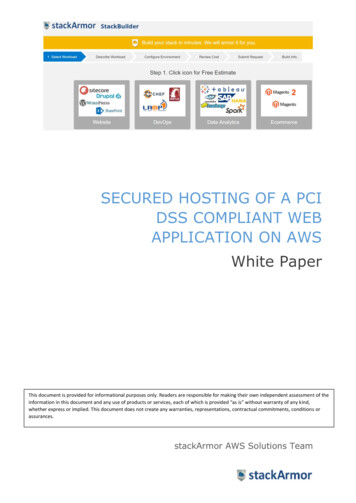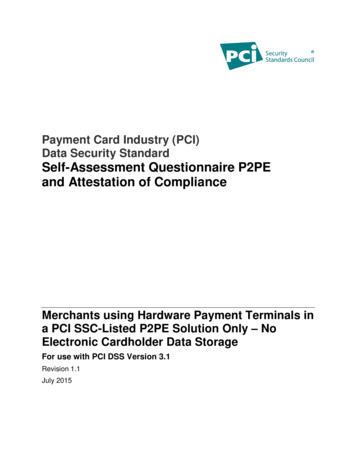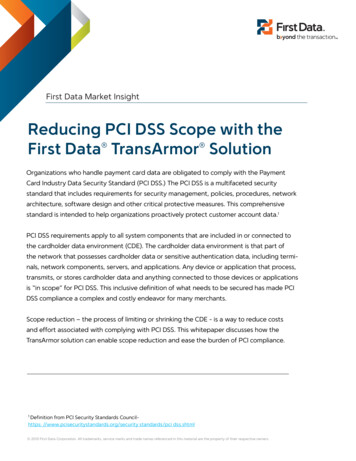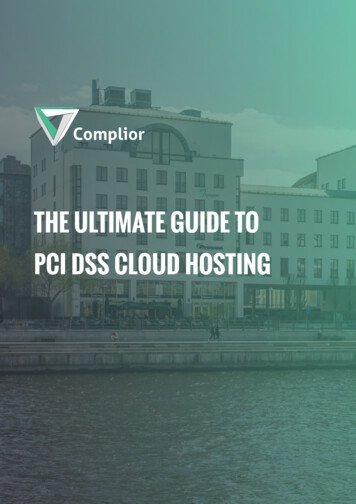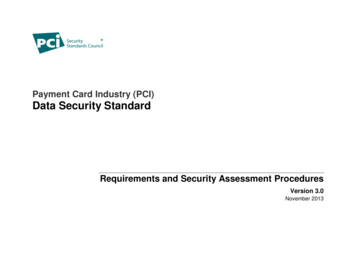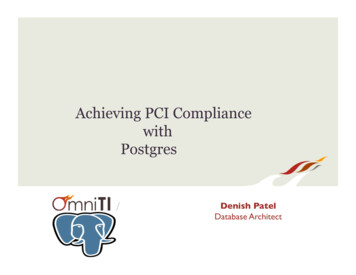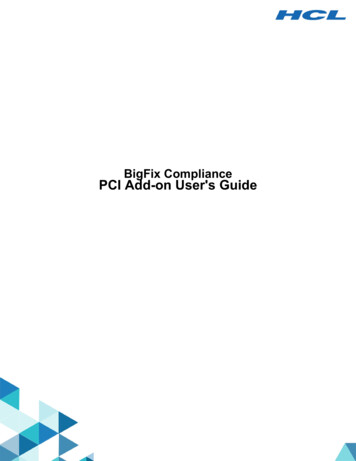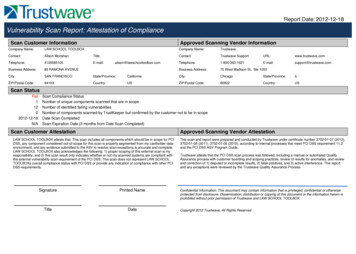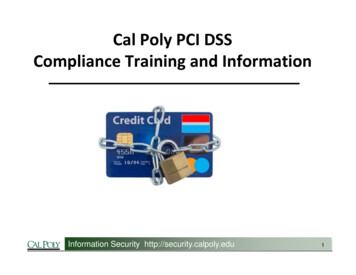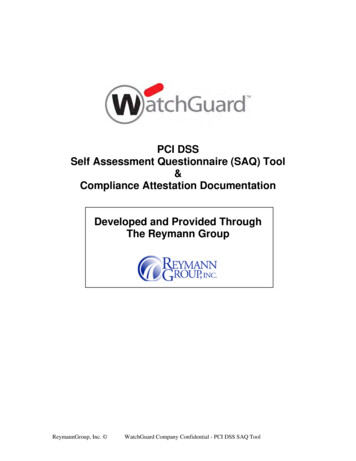
Transcription
PCI DSSSelf Assessment Questionnaire (SAQ) Tool&Compliance Attestation DocumentationDeveloped and Provided ThroughThe Reymann GroupReymannGroup, Inc. WatchGuard Company Confidential - PCI DSS SAQ Tool
CONTENTSHow to get the most value fromthis tool.3Questions and test proceduresfor: Building and maintaining a securenetwork . Protecting cardholder data Maintaining a vulnerabilitymanagement program . . Implementing strong access controlmeasures . . Regularly monitoring and testingnetworks . . Maintaining an information securitypolicy . Compensating controls . PCI DSSSELF ASSESSMENTQUESTIONNAIRE (SAQ)TOOL&COMPLIANCEATTESTATIONDOCUMENTATIONThis Document:4111622303641Purpose of this Tool:The folowing teplate is prvided as aneasy way for merchnts to use theWatchGuard solution and other technologiesand processes to deliver continuouscompliance with the PCI DSS requirements.; Automates and streamlines the selfassessment process and monthlyattestation process.; Includes all of the PCI DSS selfassessment questions and applicabletesting procedures.; Aligns eah of the PCI DSS selfassessment questios againt thespecific WatchGuard solutioncapabilities, where applicable.; Provides a space for customers to fill inthe non WatchGuard requirements.; Can serve as supporting documentationfor the merchant’s monthly attestation ofPCI DSS compliance.WatchGuard supplies a m atching re port orreports fo r v alidating and testing several ofthese controls in a standardized fo rmat thatcan be p rinted ea ch mo nth and attached tothe attestation report. It can al so be used inthe event that customers must provecompliance to an inte rnal or external a uditoror as forensic follow-up resulting from amaterial event.JANUARY 2009ReymannGroup, Inc. WatchGuard Company Confidential - PCI DSS SAQ Tool
PCI DSS Self Assessment Tool and Supporting Attestation DocumentationHOW TO GET THE MOST VALUE FROM THIS TOOL:oStep 1: Download the SAQ Tool online at the WatchGuard website.oStep 2: Read each question and test procedure carefully and select YES or NO for each question, asappropriate. WatchGuard has already provided the necessary information where the WatchGuard UTMappliance solution is deployed.oStep 3: Save the final results and print a copy of the report as the completed report for submission (in hardcopy or electronic PDF) as the company’s monthly self-assessment and attestation for PCI DSS complianceto the Merchant Acquire Bank.ReymannGroup, Inc. WatchGuard Company Confidential - PCI DSS SAQ ToolPage 3 of 41
Build and Maintain a Secure NetworkRequirement 1: Install and maintain a firewall configuration to protect dataQuestionYesNoIn addition to the WatchGuard capabilities, additional reviews should be performed on firewall configurationsand other like systems outside of the WatchGuard capabilities.Do established firewall configuration standards include the following?1.1Test Procedure:Obtain and inspect the firewall and router configuration standards and other documentation specifiedbelow to very that standards are complete.A formal process for approving and testing all external network connections and1.1.1changes to the firewall and router configuration?Test Procedure:Verify that there is a formal process for testing and approval of all network connections and changes tofirewall and router configurations.A current network diagram with all connections to cardholder data, including any1.1.2wireless networks?Test Procedure:a. Verify that a current network diagram (e.g., one that shows cardholder data flows over thenetwork) exists and that it documents all connections to cardholder data, including any wirelessnetworks.b. Verify that the diagram is kept current.Requirements for a firewall at each Internet connection and between any1.1.3demilitarized zone (DMZ) and the internal network zone?Test Procedure:Verify that firewall configuration standards include requirements for a firewall at each Internetconnection and between any DMZ and the internal network zone. Verify that the current networkdiagram is consistent with the firewall configuration standards.Description of groups, roles, and responsibilities for logical management of1.1.4network components?Test Procedure:Verify that firewall and router configuration standards include a description of groups, roles, andresponsibilities for logical management of network components.Documentation and business justification for use of all services, protocols, and1.1.5ports allowed, including documentation of security features implemented for thoseprotocols considered to be insecure?Test Procedure:a. Verify that firewall and router configuration standards include a documented list of services,protocols and ports necessary for business – e.g., hypertext transfer protocol (HTTP) and SecureSockets Layer (SSL), Secure Shell (SSH), and Virtual Private Network (VPN) protocols.b. Identify insecure services, protocols, and ports allowed; and verify they are necessary and thatsecurity features are documented and implemented by examining firewall and router configurationstandards and settings for each service. An example of an insecure service, protocol, or port isFTP, which passes user credentials in clear-text.Requirement to review firewall and router rule sets at least every six months?1.1.6Test Procedure:a. Verify that firewall and router configuration standards require review of firewall and router rule setsat least every six months.b. Obtain and examine documentation to verify that the rule sets are reviewed at least every sixmonths.Does the firewall configuration restrict connections between untrusted networks1.2and any system in the cardholder environment?Note: An “untrusted network” is any network that is external to the networksbelonging to the entity under review, or which is out of the entity’s ability to controlor manage.ReymannGroup, Inc. WatchGuard Company Confidential - PCI DSS SAQ ToolPage 4 of 41
Build and Maintain a Secure NetworkRequirement 1: Install and maintain a firewall configuration to protect dataQuestion1.2.11.2.21.2.31.3YesNoTest Procedure:Examine firewall and router configurations to verify that connections are restricted between untrustednetworks and system components in the cardholder data environment.The XTM Proxy architecture is ideal for meeting these requirements. The Proxy architectureprovides detailed control over which protocols, ports and content are allowed through the firewall. Thisis achieved by blocking all traffic by default and defining a proxy policy that allows only approved trafficto pass into the cardholder data environment. The XTM IPS and AV services can also be used toscan the allowed traffic to monitor for threats from malware or unauthorized intrusion attempts.Restrict inbound and outbound traffic to that which is necessary for the cardholderdata environment?Test Procedure:a. Verify that inbound and outbound traffic is limited to that which is necessary for the cardholderdata environment, and that the restrictions are documented.b. Verify that all other inbound and outbound traffic is specifically denied, for example by using anexplicit “demy all” or an implicit deny after allow statementThe XTM Proxy architecture provides granular control over which protocols, ports and content areallowed through the firewall. Using the XTM Proxy technology will block ALL traffic except for thatexplicitly defined by the user.Secure and synchronize router configuration files?Test Procedure:Verify that router configuration files are secure and synchronized—for example, running configurationfiles (used for normal running of the routers) and start-up configuration files (used when machines arere-booted), have the same, secure configurations.This requirement only affects an XTM if used as primary router. If this is the case, then theWatchGuard System Manager may be used to define and deploy a synchronized configuration to eachXTM that will then be applied during the startup of each appliance.Include installation of perimeter firewalls between any wireless networks and thecardholder data environment, and configure these firewalls to deny or control (ifsuch traffic is necessary for business purposes) any traffic from the wirelessenvironment into the cardholder data environment?Test Procedure:Verify that there are perimeter firewalls installed between any wireless networks and systems thatstore cardholder data, and that these firewalls deny or control (if such traffic is necessary for businesspurposes) any traffic from the wireless environment into the cardholder data environment.If using an XTM appliance: Using port independence, an interface can be assigned to the Wireless Access Point (WAP) andpolicies defined to ensure that no traffic from the WAP is allowed to enter the cardholder dataenvironment.If using an XTM 2 Series appliance as the WAP: The 2 Series can be configured so that the wireless traffic is isolated from the cardholder dataenvironment via firewall policy.Does the firewall configuration prohibit direct public access between the Internetand any system component in the cardholder data environment?Test Procedure:Examine firewall and router configurations, as detailed below, to determine that there is no directaccess between the Internet and system components, including the choke router at the Internet, theDMZ router and firewall, the DMZ cardholder segment, the perimeter router, and the internalcardholder network segment.ReymannGroup, Inc. WatchGuard Company Confidential - PCI DSS SAQ ToolPage 5 of 41
Build and Maintain a Secure NetworkRequirement 1: Install and maintain a firewall configuration to protect dataQuestionYesNoThis relates specifically to the use of a “zoned” network architecture to prevent direct access to thecardholder data environment from the Internet. A zoned network is one that is grouped into subnets,with each segment set aside for a specific function or IP Range. At a minimum, a PCI DSS network issegregated into two subnets; a demilitarized zone (or DMZ) for the public facing servers and thecardholder data environment (or “trusted” zone).1.3.11.3.21.3.31.3.41.3.51.3.6Public facing servers placed into the DMZ subnet protect the cardholder data environment in case anintruder succeeds in penetrating them. An intervening firewall controls the traffic between the DMZservers and the internal network clients. XTM appliances can be used as the intervening firewall,establishing the subnets for each zone and controlling the traffic that passes from one zone to another.Is the DMZ implemented to limit inbound and outbound traffic to only protocols thatare necessary for the cardholder environment?Test Procedure:Verify that a DMZ is implemented to limit inbound and outbound traffic to only protocols that arenecessary for the cardholder data environment.To match the requirements for this section, an XTM must be configured to create a DMZ for all publicfacing servers and a “Trusted” zone for the cardholder data environment. Proxy policies are then usedto provide detailed control over which protocols, ports and content are allowed into and out of eachzone.Is inbound Internet traffic limited to IP addresses within the DMZ?Test Procedure:Verify that inbound Internet traffic is limited to IP addresses within the DMZ.With an XTM in a “zoned” network configuration, all traffic passed between the Internet and theinternal network can only go to and from servers at public facing IP addresses within the DMZ,prohibiting any direct routes for either inbound or outbound Internet traffic to the cardholder dataenvironment.Are direct routes prohibited for inbound and outbound traffic between the Internetand the cardholder data environment?Test Procedure:Verify there is no direct route inbound or outbound for traffic between the Internet and the cardholderdata environment.With an XTM in a “zoned” network configuration, all traffic passed between the Internet and theinternal network can only go to and from servers at public facing IP addresses within the DMZ,prohibiting any direct routes for either inbound or outbound Internet traffic to the cardholder dataenvironment.Are internal addresses prohibited from passing from the Internet to the DMZ?Test Procedure:Verify that internal addresses cannot pass from the Internet into the DMZ.An XTM in a “zoned” network configuration ensures that: All incoming traffic from the Internet not destined for a public IP address in the DMZ is denied.Is outbound traffic restricted from the cardholder data environment to the Internetsuch that outbound traffic can only access IP addresses within the DMZ?Test Procedure:Verify that outbound traffic from the cardholder data environment to the Internet can only access IPaddresses within the DMZ.An XTM in a “zoned” network configuration ensures that: All traffic FROM the cardholder data environment going to an IP address not within the DMZ isdenied, ensuring that all data FROM the cardholder data environment cannot be routed directly tothe Internet.Is stateful inspection, also know as dynamic packet filtering, implemented (that is,only established connections are allowed into the network)?ReymannGroup, Inc. WatchGuard Company Confidential - PCI DSS SAQ ToolPage 6 of 41
Build and Maintain a Secure NetworkRequirement 1: Install and maintain a firewall configuration to protect dataQuestion1.3.71.3.81.4YesNoTest Procedure:Verify that the firewall performs stateful inspection (dynamic packet filtering). [Only establishedconnections should be allowed in, and only if they are associated with a previously established session(run a port scanner on all TCP ports with “syn reset” or ”syn ack” bits set—a response means packetsare allowed through even if they are not part of a previously established session).]The Proxy technology used in XTM appliances go beyond basic stateful inspection and alsoincorporate other technologies, such as Protocol Anomaly Detection and Intrusion Prevention Servicesthat can be used to meet or exceed the objectives of this requirement.Is the database placed in an internal network zone, segregated from the DMZ?Test Procedure:Verify that the database is on and internal network zone is segregated from the DMZ.Has IP-masquerading been implemented to prevent internal addresses from beingtranslated and revealed on the Internet, using RFC 1918 address space?Test Procedure:For the sample of firewall and router components, verify that NAT or other technology using RFC 1918address space is used to restrict broadcast of IP addresses from the internal network to the Internet (IPmasquerading).With dynamic NAT, the XTM replaces the private IP address included in a packet sent from acomputer protected by the XTM with the public IP address of the XTM itself. By default, dynamicNAT is enabled and active for RFC 1918 private network addresses.Has personal firewall software been installed on any mobile or employee-ownedcomputers with direct connectivity to the Internet (e.g., laptops used byemployees), which are used to access the organization’s network?Test Procedure:a. Verify that mobile and employee-owned computers with direct connectivity to the Internet (e.g.,laptops used by employees), and which are used to access the organization’s network, havepersonal firewall software installed and active.b. Verify that the personal firewall software is configured by the organization to specific standardsand is not alterable by mobile computer uses.ReymannGroup, Inc. WatchGuard Company Confidential - PCI DSS SAQ ToolPage 7 of 41
Build and Maintain a Secure NetworkRequirement 2: Do not use vendor-supplied defaults for system passwords and other security parametersQuestionYesNoIn addition to the WatchGuard capabilities, additional reviews should be performed on vendor supplied defaultsfor system passwords and other security parameters outside of the WatchGuard capabilities.Are vendor-supplied defaults changed before installing a system on the network?2.1(Examples include passwords, simple network management protocol (SNMP)community strings, and elimination of unnecessary accounts.)Test Procedure:Choose a sa mple of sy stem components, critical servers, and wireless access points, an d attempt tolog on (with system ad ministrator help ) to the devices usin g de fault vendor-sup plied a ccounts an dpasswords, to verify that default accounts and passwords have been changed. (Use vendo r manualsand sources on the Internet to find vendor- supplied accounts and passwords.)Are defaults** for wireless environments connected to the cardholder data2.1.1environment or transmitting cardholder data changed before installing a wirelesssystem? Are wireless device security settings enabled for strong encryptiontechnology for authentication and transmissions?** Such wireless environment defaults include but are not limited to, defaultwireless encryption keys, passwords, and SNMP community strings.Test Procedure:Verify the following regarding vendor default settings for wireless environments and ensure that allwireless networks implement strong encryption mechanisms (for example AES):a. Encryption keys were changed from default at installation and are changed at anytime anyone withknowledge of the keys leaves the company or changes positions.b. Default SNMP community strings on wireless devices were changed.c. Default passwords/passphrases on access points were changed.d. Firmware on wireless devices is updated to support strong encryption for authentication andtransmission over wireless networks (for example, WPA/WPA2).e. Other security-related wireless vendor defaults, if applicable.Have configuration standards been developed for all system components? Do2.2.athese standards address all known security vulnerabilities and are they consistentwith industry-accepted system hardening standards – e.g., by SysAdmin AuditNetwork Security Networks (SANS), National Institute of Standards Technology(NIST), and Center for Internet Security (CIS)?Test Procedure:a. Examine the organization’s system configuration standards for all types of system componentsand verify the system configuration standards are consistent with industry-accepted hardeningstandards - e.g., SysAdmin Audit Network Security (SANS), National Institute of StandardsTechnology (NIST), and Center for Internet Security(CIS).b. Verify that system configuration standards are applied when new systems are configured.Do controls ensure the following?2.2.bIs only one primary function implemented per server?2.2.1Test Procedure:For a sample of system components, verify that only one primary function is implemented per server.For example, web servers, database servers, and DNS should be implemented on separate servers.Do controls ensure that all unnecessary and insecure services and protocols are2.2.2disabled (services and protocols not directly needed to perform the devices’specified function)?Test Procedure:For a sample of system components, inspect enabled system services, daemons, and protocols.Verify that unnecessary or insecure services or protocols are not enabled, or are justified anddocumented as to appropriate use of the service. For example, FTP is not used, or is encrypted viaSSH or other technology.ReymannGroup, Inc. WatchGuard Company Confidential - PCI DSS SAQ ToolPage 8 of 41
Build and Maintain a Secure NetworkRequirement 2: Do not use vendor-supplied defaults for system passwords and other security parametersQuestionYesNo2.2.32.2.42.32.4XTM appliances’ Proxy architecture provides detailed control over which protocols, ports andcontent are allowed passage through the firewall. This is achieved by blocking all traffic by default anddefining a proxy policy for those specific protocols that are allowed.Do controls ensure that system parameters are configured to prevent misuse?Test Procedure:a. Interview system administrators and security managers to verify that they have knowledge ofcommon security parameter settings for system components.b. Verify that common security parameter settings are included in the system configurationstandards.c. For a sample of system components, verify that common security parameters are setappropriately.XTM configuration can only be achieved through the use of Administrative pass phrases. Differentpass phrases are required for reading and writing XTM configurations to the appliance.Has all unnecessary functionality – such as scripts, drivers, features, subsystems,file systems, and unnecessary web servers – been removed?Test Procedure:For a sample of system components, verify that all unnecessary functionality (e.g., scripts, drivers,features, subsystems, file systems, etc.) is removed. Verify enabled functions are documented andsupport secure configuration and that only documented functionality is present on the samplemachines.Is all non-console administrative access encrypted?Use technologies such as SSH, VPN, or SSL/TLS for web-based managementand other non-console administrative access.Test Procedure:For a sample of system components, verify that non-console administrative access is encrypted by:a. Observing an administrator log on to each system to verify that a strong encryption method isinvolved before the administrator’s password is requested.b. Reviewing services and parameter files on systems to determine that Telnet and other remote login commands are not available for use internally.c. Verifying that administrator access to the web-based management interfaces is encrypted withstrong cryptography.All management communications with XTM appliances are done via a secure encryption-basedprotocol.If you are a hosting provider, are your systems configured to protect each entity’shosted environment and cardholder data?ReymannGroup, Inc. WatchGuard Company Confidential - PCI DSS SAQ ToolPage 9 of 41
Build and Maintain a Secure NetworkRequirement 2: Do not use vendor-supplied defaults for system passwords and other security parametersQuestionYesNoTest Procedure:Perform testing procedures A.1.1 through A.1.4 detailed in Appendix A: Additional PCI DSSRequirements for Shared Hosting Providers for PCI DSS assessments of shared hosting providers, toverify that shared hosting providers protect their entities’ (merchants and service providers) hostedenvironment and data.A.1.1 - If a shared hosting provider allows entities (e.g., merchants or service providers) to run theirown applications, verify these application processes run using the unique ID of the entity. For example:a. No entity on the system can use a shared web server user ID.b. All CGI scripts used by an entity must be created and run as the entity’s unique user ID.A.1.2 – Verify:a. The user ID of any application process is not a privileged user (root/admin).b. Each entity (merchant, service provider) has read, write, or execute permissions only for files anddirectories it owns or for necessary system files (restricted via file system permissions, accesscontrol lists, chroot, jailshell, etc.). IMPORTANT: An entity’s files may not be shared by group.c. An entity’s users do not have write access to shared system binaries.d. Viewing of log entries is restricted to the owning entity.e. Restrictions are in place for the user of these system resources: disk space; bandwidth; memory;and CPU. This is to ensure that each entity cannot monopolize server resources to exploitvulnerabilities (e.g., error, race, and restart conditions, resulting in, for example, buffer overflows).A.1.3 - Verify the shared hosting provider has enabled logging as follows, for each merchant andservice provider environment:a. Logs are enabled for common third-party applications.b. Logs are active by default.c. Logs are available for review by the owning entity.d. Log locations are clearly communicated to the owning entity.A.1.4 - Verify the shared hosting provider has written policies that provide for a timely forensicsinvestigation of related servers in the event of a compromise.ReymannGroup, Inc. WatchGuard Company Confidential - PCI DSS SAQ ToolPage 10 of 41
Protect Cardholder DataRequirement 3: Protect stored cardholder dataQuestionYesNoIn addition to the WatchGuard capabilities, additional reviews should be performed on protection of storedcardholder data outside of the WatchGuard capabilities.Is storage of cardholder data kept to a minimum, and is storage amount and3.1retention time limited to that which is required for business, legal, and regulatorypurposes? Is there a data-retention and disposal policy, and does it include suchlimitations?Test Procedure:Obtain and examine the company policies and procedures for data retention and disposal and verifythat policies and procedures include:a. Legal, regulatory, and business requirements for data retention, including specific requirements forretention of cardholder data(e.g., cardholder data needs to be held for X period for Y businessreasons).b. Provisions for disposal of data when no longer needed for legal, regulatory, or business reasons,including disposal of cardholder data.c. Coverage for all storage of cardholder data.d. A programmatic (automatic) process to remove, at least on a quarterly basis, stored cardholderdata that exceeds business retention requirements, or alternatively, requirements for a review thatis conducted at least on a quarterly basis to verify that stored cardholder data does not exceedbusiness retention requirements.Do all systems adhere to the following requirements regarding storage of sensitive3.2authentication data after authentication (even if encrypted)?Test Procedure:If sensitive authentication data is received and deleted, obtain and review the processes for deletingthe data to verify that the data is unrecoverable.Do not store the full contents of any track from the magnetic stripe (located on the3.2.1back of a card, in a chip or elsewhere). This data is alternatively called full track,track, track 1, track 2, and magnetic stripe data.In the normal course of business, the following data elements from the magneticstripe may need to be retained: The cardholder’s name, primary account number(PAN), expiration date, and service code. To minimize risk, store only those dataelements as needed for business. NEVER store the card verification code or valueor PIN verification value data elements.Test Procedure:For a sample of system components, examine the following and verify the full contents of any trackfrom the magnetic stripe on the back of card are not stored under any circumstance:a. Incoming transaction datab. All logs(e.g., transaction, history, debugging, error)c. Hist ory filesd. Tra ce filese. Several database schemasf. Database contentsDo not store the card-validation code or value (three-digit or four-digit number3.2.2printed on the front or back of a payment card) used to verify card-not-presenttransactions.ReymannGroup, Inc. WatchGuard Company Confidential - PCI DSS SAQ ToolPage 11 of 41
Protect Cardholder DataRequirement 3: Protect stored cardholder dataQuestion3.2.33.33.4YesNoTest Procedure:For a sample of system components, verify that the three-digit or four-digit card-verification code orvalue printed on the front of the card or the signature panel (CVV2, CVC2, CID, CAV2 data) is notstored under any circumstance:a. Incoming transaction datab. All logs (e.g., transaction, history, debugging, error)c. Hist ory filesd. Tra ce filee. Several database schemasf. Database contentsDo not store the personal identification number (PIN) or the encrypted PIN block.Test Procedure:For a sample of system components, examine the following and verify that PINs and encrypted PINblocks are not stored under any circumstances:a. Incoming transaction datab. All logs (e.g., transaction, history, debugging, error)c. Hist ory filesd. Tra ce filee. Several database schemasf. Database contentsIs the PAN masked when displayed (the first six and last four digits are themaximum number of digits to be displayed).Note: This requirement does not apply to employees and other parties with aspecific need to see the full PAN; nor does the requirement supersede stricterrequirements in place for displays of cardholder data (e.g., for point-of-sale (POS)receipts).Test Procedure:Obtain and examine written policies and examine displays of PAN (e.g., on screen, on paper receipts)to verify that primary account numbers (PANs) are masked when displaying cardholder data, exceptfor those with a legitimate business need to see full PAN.Is PAN, at a minimum, rendered unreadable anywhere it is stored (including dataon portable digital media, back-up media, and in logs,) by using any of thefollowing approaches? One-way hashes based on strong cryptography Trun cation Index tokens and pads(pads must be securely stored) Strong cryptography with associated key management processes andprocedures.The MINIMUM account information that must be rendered unreadable is the PAN.If for some reason, a company is unable to render the PAN unreadable, refer to“Compensating Controls.”ReymannGroup, Inc. WatchGuard Company Confidential - PCI DSS SAQ ToolPage 12 of 41
Protect Cardholder DataRequirement 3: Protect stored cardholder NoTest Procedure:a. Obtain and examine documentation about the system used to protect the PAN, including thevendor, type of system/process, and the encryption algorithms (if applicable). Verify that the PANis rendered unreadable using one of the following methods: One-way hashes based on strong cryptography. Trunc ation. Index tokens and pads with the pads being securely stored. Strong cryptography with associated key-management processes and procedures.b. Examine several tables or files from a sample of data repositories to verify the PAN is renderedunreadable (that is, not stored in plain-text).c. Examine a sample of removable media (e.g., back-up tapes) to confirm that the PAN is renderedunreadable.
compliance with the PCI DSS requirements. JANUARY 2009 PCI DSS SELF ASSESSMENT QUESTIONNAIRE (SAQ) TOOL & COMPLIANCE TTESTATION DOCUMENTATION This Document: ; Automates and streamlines the self-assessment proess and mnthly oc attestation process. ; Includs all of the PCI DSS see f- l assessment questions an appliable c d testing procedures.
